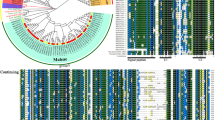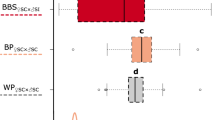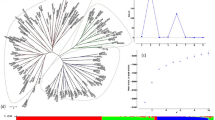Summary
Nineteen different S alleles were found in 488 plants representing 16 cultivars of Brussels sprouts. Twelve of these S alleles have previously been found in kale, and 7 are known only from Brussels sprouts. The number of S alleles per cultivar varied from 4 to 13, but for most cultivars the number fell in the range 7–10. Relatively unselected cultivars tend to have more S alleles than highly selected ones. In every cultivar the S allele frequencies are very unequal. The alleles with the greatest overall frequency are S2 and S5 and in almost all the cultivars tested one of these two alleles is the commonest. The rare S alleles not only occur at very low frequencies, but also occur in few cultivars. The commonest S alleles are recessive and the rare alleles are dominant. Dominant S alleles normally confer a higher degree of self-incompatibility than recessive S alleles. In Brussels sprouts cultivars a dynamic balance between outbreeding and inbreeding is achieved through the S allele system. The recessive S alleles, when present at high frequencies, allow some inbreeding, while the dominant S alleles promote outbreeding even when they are present at low frequencies. Because dominant S alleles confer high levels of self-incompatibility it is desirable to incorporate them into inbred lines used for the production of F1 hybrid cultivars of Brussels sprouts. Such dominant alleles do occur in Brussels sprouts, but are rare and at least 20, and preferably 50, plants of a cultivar should be tested if rare S alleles are being sought.
Similar content being viewed by others
Article PDF
References
Bateman, A J. 1947. Number of S alleles in a population. Nature, 160, 337.
Bateman, A J. 1954. Self-incompatibility systems in Angiosperms. II. Iberis amara. Heredity, 8, 305–332.
Emerson, S. 1939. A preliminary survey of the Oenothera organensis population. Genetics, 24, 524–537.
Haruta, T. 1962. Studies on the genetics of self-and cross-incompatibility in cruciferous vegetables. Res Bull No 2 Takii Pl Breed Exp Stn, Kyoto, Japan.
Johnson, A G. 1971. Factors affecting the degree of self-incompatibility in inbred lines of Brussels sprouts. Euphytica, 20, 561–573.
Johnson, A G. 1972. Problems in breeding and seed production of hybrid sprouts. Comml Grow, No. 4012, pp. 749–750.
Ockendon, D J. 1972. Incompatibility studies. National Vegetable Research Station Ann Rep for 1971, pp. 28–29.
Pandey, K K. 1972. Origin of genetic variation: regulation of genetic recombination in the higher organisms—a theory. Theoret Appl Genetics, 42, 250–261.
Sampson, D R. 1967. Frequency and distribution of self-incompatibility alleles in Raphanus raphanistrum. Genetics, 56, 241–251.
Thompson, K F. 1957. Self-incompatibility in marrow-stem kale, Brasswa oleracea var acephala. I. Demonstration of a sporophytic system. J Genetics, 55, 45–60.
Thomson, K F. 1968. Classified S alleles for Brassica breeders. In Brasswa meeting of Eucarpia (G. E. Dixon, ed.), pp. 25–28.
Thomson, K F, and Taylor, J P. 1966. The breakdown of self-incompatibility in cultivars of Brassica oleracea. Heredity, 21, 637–648.
Thompson, K F, and Taylor, J P. 1971. Self-compatibility in kale. Heredity, 27, 459–471.
Watts, L E. 1963. Investigation into the breeding system of cauliflower Brassica oleracea var botrytis L. I. Studies of self-incompatibility. Euphytica, 12, 323–340.
Williams, W. 1947. Genetics of red clover (Trifolium pratense L) compatibility. III. The frequency of incompatibility S alleles in two non-pedigree populations of red clover. J Genetics, 48, 69–79.
Wright, S. 1939. The distribution of self-sterility alleles in populations. Genetics, 24, 538–552.
Wright, S. 1964. The distribution of self-sterility alleles in populations. Evolution, 18, 609–619.
Author information
Authors and Affiliations
Rights and permissions
About this article
Cite this article
Ockendon, D. Distribution of self-incompatibility alleles and breeding structure of open-pollinated cultivars of Brussels sprouts. Heredity 33, 159–171 (1974). https://doi.org/10.1038/hdy.1974.84
Received:
Issue date:
DOI: https://doi.org/10.1038/hdy.1974.84
This article is cited by
-
Molecular cloning and expression analysis of SRLK1 gene in self-incompatible Asteraceae species Erigeron breviscapus
Molecular Biology Reports (2019)
-
Progress on deciphering the molecular aspects of cell-to-cell communication in Brassica self-incompatibility response
3 Biotech (2018)
-
Sporophytic self-incompatibility in Senecio squalidus (Asteraceae): S allele dominance interactions and modifiers of cross-compatibility and selfing rates
Heredity (2011)
-
Phylogenetic Analysis of S-Locus Genes Reveals the Complicated Evolution Relationship of S Haplotypes in Brassica
Plant Molecular Biology Reporter (2011)
-
Progress on characterization of self-incompatibility in Brassica napus L.
Euphytica (2011)



